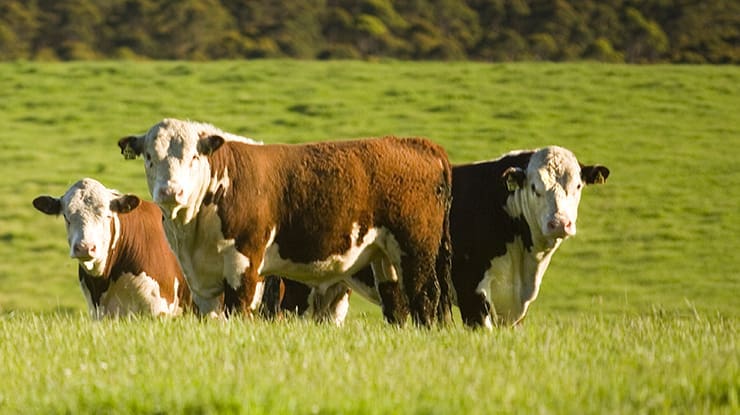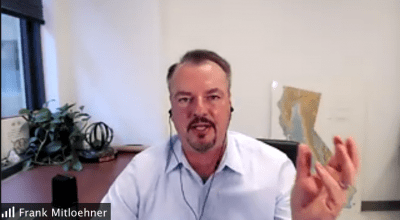The Australian red meat industry has set a target to achieve “carbon neutrality” by 2030, which means that within nine years, Australian beef, lamb and goat production, including lot feeding and meat processing, will make no net release of greenhouse gas emissions into the atmosphere.
But the question was raised in a recent forum – isn’t “climate neutrality” a more apt description for that goal?
Air quality scientist Dr Frank Mitloehner made that point during a Cattle Council of Australia-hosted webinar in mid-December.
“In my opinion, to attempt to be carbon neutral is something a car manufacturer should be,” he said, noting that the Paris Climate Accord was really about the climate and global temperatures, not carbon.
“We don’t want world temperatures to increase, we want to keep the climate constant, and not the carbon constant, so it is really about the climate, and it is really about the warming footprint that we should worry about.”
Dr Mitloehner said that methane emissions from cattle herds in Australia, the US, Canada and many European countries have reduced in recent decades.
“Our methane has gone down, and when methane goes down, beautiful things happen.”
‘When methane goes down, beautiful things happen’
A key aspect of this issue is the debate that has emerged around how methane emissions should be counted.
Counter intelligence
Most countries have adopted what is known as the GWP 100 (Global Warming Potential over 100 years) accounting framework which provides a convenient single system for measuring the equivalent impacts of different types of gases, and which enables a global system of carbon trading.
The problem for the cattle industry however is that GWP 100 doesn’t account for very real differences in the way methane from biogenic sources such as cattle behave in the atmosphere compared to other greenhouse gases like carbon dioxide or nitrous oxide, and as a result can dramatically over estimate the affect methane emissions from sources such as cattle can have on atmospheric temperature.
In effect methane emissions from a stable or reducing herd do not put additional methane in the atmosphere, Dr Mitloehner says, and thus do not contribute to increased temperatures in the way that emissions from burning of fossil fuels would.
A herd that is reducing in size will reduce the amount of methane in the atmosphere resulting in a cooling effect, as opposed to a warming effect, Dr Mitlhoener says.
This is not necessarily a “get out of jail” card for the cattle industry because it means that if a herd grows substantially the resulting additional methane emissions would have a warming outcome.
A new framework designed to account for these differences, known as GWP Star, was developed by a team at University of Oxford led by Professor Myles Allen.
The issue now is whether GWP star will be accepted in addition to GWP 100 to ensure climate policies are based on the most appropriate system of accounting for what changes of methane mean for the climate.
At the same time Dr Mitlhoener message to the industry was not to think that methane “doesn’t matter”.
Just as when methane goes down, beautiful things happen, when methane goes up, “terrible things happen”, he says.
“We don’t want methane to go up, that increases warming, it is a powerful climate pollutant.
“When methane stays stable like it has been in many countries, then that means you don’t add additional warming.
“But if you manage to reduce methane through feed additives, through manure management, through other means, then you can contribute to a cooling effect of that methane portion of your operation which will counteract some of the warming impact that nitrous oxide and arbon dioxide might have leading to a path of climate neutrality for your sector, and that is really important.”
MLA investgating a ‘climate neutral’ position for beef industry
Participating in the same webinar was Meat & Livestock Australia manager, Sustainability Innovation, Doug McNicholl, who commented that MLA is actively investigating a “climate neutral position” for the red meat industry, in addition to its current work towards carbon neutrality under the CN30 goal.
Progress towards the Australian red meat industry CN30 goal is currently measured using GWP 100 metrics, which is consistent with the approach used by Commonwealth Government and the IPCC and many other countries around the world.
However Mr McNicholl said MLA is also working with the CSIRO to analyse the industry’s case for a climate neutral position using the GWP Star metric, with a view to reporting the industry’s position using both GWP 100 and GWP star metrics in future.
“We will continue emissions accounting using the GWP 100 metric, unless the Commonwealth Government decides to stop, and they have given us no indication they intend to change, but we will report both and we are well within our rights to do that,” he said.
Mr McNicholl also made the point that regardless of whether a GWP 100 or GWP Star accounting metric was used, the need remains for technologies to reduce methane emissions and improve productivity, such as feed additives which could be incorporated into both feedlot rations and supplementary feeding programs in grassfed grazing systems.
He said that while it was true to say that it would be impossible to eliminate emissions, CSIRO research had demonstrated it was possible to reduce enteric emissions from cattle and to increase offsets to achieve a net zero position.
Two basket approach to climate policy ‘perfectly sensible’
In a recent interview with Beef Central, Ruaraidh Petre, the executive director of the Global Roundtable for Sustainable Beef (GRSB), said “climate neutrality” is central to the industry’s goals.
“I would agree with Frank in the sense that climate neutrality, if you use things like GWP Star, then you can reach climate neutrality before you necessarily reach carbon neutrality,” Mr Petre said.
There is a view that GWP Star will be never be widely adopted because the 2015 Paris Agreement talks were all based on GWP 100 and are now universally embedded and non-changeable.
But Mr Petre said that was not true, a message which he said was emphasised in a recent GRSB webinar by Adjunct Professor Adrian Macey, the first climate ambassador for New Zealand who chaired the Kyoto Protocol negotiations and, through his active involvement with the process, has an in depth understanding of climate negotiations held annually.
“He is very clear that the metrics are up to each country and there is no reason that one metric has to be used for all gases, and indeed that if warming is what you care about it would be better not to use the same metric for all gases,” Mr Petre said (This ‘two-basket approach’ to climate policy is explored in more detail by Adrian Macey and Professor Dave Frame in this 2019 New Zealand Herald article).
Professor Macey’s message to the recent GRSB webinar was that the Paris Agreement doesn’t tell any country which metrics they are supposed to use, rather, it tells them to pick a metric and be consistent with it.
“His argument is that you use different metrics for different things, and you can use a mixture of metrics as long as you are consistent,” Mr Petre said.
“So if you talk about your livestock industry using GWP star, and you always do that, then that should be acceptable.”




